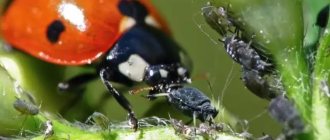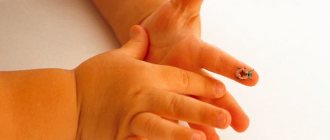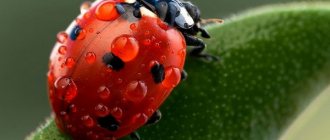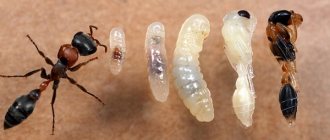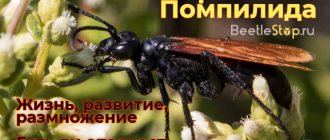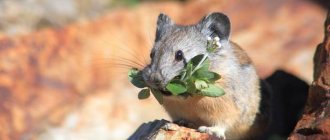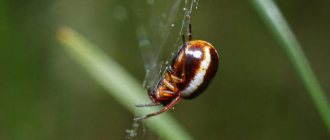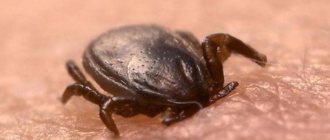History of the name
If we consider the Latin name of the insect, in translation it means “scarlet”, which corresponds to the color of the bug. And the popular name appeared quite a long time ago due to sympathy for this insect. In Germany and Switzerland, the creature is called the “Virgin Mary’s bug”; in Slovenia and the Czech Republic, the insect is known as the “sun” (as many are accustomed to calling the ladybug in Russia). This creature also lives in Latin American countries, and they call it “St. Anthony’s bug.”
The origin of the domestic name ladybug is currently unknown. Some researchers believe that the bug received this name due to its ability to destroy aphids. Thus, a simple creature helps preserve huge crop plantations. It becomes clear what ladybugs eat.
Brief information
Ladybugs are divided into two subfamilies of beetles: Microweiseinae and Coccinellinae. The territory of Russia and the CIS countries is inhabited mainly by beetles of the family Coccinellinae.
About 6,000 species are known throughout the world; about 260 species live in Europe, including Russia. The beetle benefits gardeners as it successfully fights various garden pests.
Interesting Facts
- The dots on the back of the ladybug do not allow us to draw conclusions about its age. The dots indicate that it belongs to a specific species.
- The beetle eats about 100 aphids per day.
- In nature, there are also yellow, orange, brown and black beetles, not just red.
- After hatching from the larva, it turns red after several flowers.
- They are poikilothermic (warm to the touch) animals.
- The Asian harlequin ladybug (H. axyridis) (orange and 19 spots) is threatening to wipe out the European ladybug variety. It reproduces massively and quickly, is resistant to parasites and competes with local beetles for food.
Harlequin ladybug (H. axyridis)
H. axyridis has been recognized as an insect pest in fruit production and processing. In the fall, there is a shortage of insects to feed them and adult harlequins begin to gather in flocks and feed on fruits such as apples, pears and grapes. This causes damage to the harvest, and toxic alkaloids that fall on the grapes further spoil the wine.
Basic characteristics of an insect
A ladybug is a small bug, the length of which does not exceed 10 mm (in most cases it is about 6 mm). The insect has an oval or round body shape. Some species have fine hairs on the top of their wings. The body of a ladybug consists of a head, pronotum, chest, three pairs of legs and wings. The insect has a motionless head. The ladybug has relatively large eyes and antennae that are highly flexible.
Thanks to three pairs of legs, the insect can move quite quickly on grass and ground, and a little worse on sliding surfaces. Thanks to two hind wings, ladybugs move perfectly through the air.
The insect has an excellent defense mechanism against predators (animals, other insects, birds). The bug secretes a toxic yellow liquid with an unpleasant odor. The bright colors of the ladybug, beloved by many, also scare away enemies.
Ladybug larvae - what do they look like?
Further development occurs over 4-7 days and has several stages. The larvae are oval in appearance. They look colorful due to yellow-orange spots that form a certain pattern. Body surface with bristles, peculiar outgrowths. Newborn ladybugs that feed on scale insects are covered with whitish, waxy threads. Everything grows in 2-4 weeks.
After this stage comes the moment of pupation. To move into it, the individual attaches the back of the body to the leaf plate and curls into a semi-bent position. At the end of the internal transformation, the skin peels off the pupa, sliding like a stocking to the end of the abdomen. It does not lose its bright color with black and yellow specks. Next, from 7 to 10 days, an adult is formed.
Habitat
What does a ladybug eat in nature? It all depends on where exactly the insect is located. These bugs feel great almost anywhere in the world. They are only absent in Antarctica. Ladybugs can be found in large numbers in America, various regions of Europe and Asia. Such insects live in all countries of the former Soviet Union. They also exist on Russian territory.
Most often, insects choose to live on plants on which a colony of aphids settles. Some species prefer to settle on reeds near water bodies or in field grasses. Almost all insects lead an isolated lifestyle. They do not like to depend on their relatives. Insects gather together only during the mating season. All types of ladybugs are heat-loving. Before the onset of winter cold, insects gather in huge flocks and fly away for the winter.
Some subspecies remain to winter in Russia. Ladybugs gather in huge communities, choosing stones and tree bark as shelter. However, insects do not live long. Under favorable conditions, their life expectancy does not exceed a year. Most often, the insect lives only a few months.
What does a ladybug eat in winter?
With the end of the warm period of the year, ladybugs look for a secluded place for wintering. They choose fallen leaves, tree bark, and cracks in buildings as shelter. These beetles, which feed well throughout the season, accumulate glycerin and sugar in their tissues, which helps them maintain vitality during hibernation, but before that they remove fluid from the body so that their bodies do not burst apart in subzero temperatures.
Migratory species of ladybugs are also found in nature. They, like birds, go to warmer regions for the winter. In this case, they eat in winter the same way as the rest of the time, and with the arrival of spring they return to their native lands.
Ladybug feeding
Despite its pleasant appearance, the bug is a predator in the world of insects. Almost all species of this bug eat mites and aphids; they can also eat butterfly eggs; small caterpillars are a real delicacy. If there is no alternative food, ladybugs do not disdain the eggs of the Colorado potato beetle.
There are also subspecies of this insect that feed exclusively on plant foods. The beetles' diet includes leaves, inflorescences and plant pollen. Some insects can eat even small fruits.
What do these creatures look like?
Even a child can describe a ladybug. It is remembered by its bright color. There are:
- scarlet;
- yellow;
- bronze;
- red;
- cherry;
- brown.
The insect is small in size - up to 10 mm. The shape is convex, round.
The body structure is divided into the following parts:
- head;
- pronotum;
- breast.
The latter consists of three sections. These include paws - there are six of them; abdomen and wings with elytra.
These beetles fly using two wings located at the back. The front ones are rigid, their main function is to protect those with the help of which ladybugs fly. They have black dots or spots, depending on their type. These patterns also differentiate the sex of insects.
Stages of ladybug development
By the fifth month of life, most insects of this species reach sexual maturity. Ladybugs actively breed already in April. The bugs gain strength after hibernation and only then begin to mate. The ladybug feeds especially intensively at this time to produce healthy offspring. Thanks to the specific aroma, the male easily finds the female. The eggs are laid near aphid colonies so that in the future the young ladybug can fully feed (what the insect eats was described above). Typically, eggs attach to the underside of plant leaves. One female can lay up to 400 eggs, then she dies.
After just a few eggs, bright ladybug larvae emerge from the laid eggs. What is an insect? From the first days of life, the larva can feed on aphids and pieces of plants. The larvae can also eat the shell of the egg from which they hatched. Of the many eggs laid, not all of them fully develop; some of the embryos die. Mature larvae can also feed on these remains.
From the moment the larva appears until the full-fledged bug matures, at least a month passes. The larva pupates, and a week later a normal ladybug is born. What does a young insect eat? It all depends on the species. If it is a predator, then it will continue to feed on aphids and mites.
Origin of the species and description
Photo: Ladybug
The ladybug is a very common ancient arthropod insect all over the world, a representative of the order Coleoptera and the ladybird family. This insect received its scientific name Coccinellidae due to its scarlet color. The bug lives almost everywhere. It was popularly nicknamed the ladybug because of the poisonous white liquid or “milk” that the insect secretes to scare away predators, and the ladybug because it helped in the fight against aphids and other pests to preserve the harvest, had a gentle disposition, and did not cause any harm to humans. .
Video: Ladybug
In Germany and Switzerland, the tiny insect is called St. Mary's bug, in South America - St. Anthony's ladybug. There were many legends about this little bug; it was said to have the ability to influence the weather.
Interesting fact: Even in ancient times, the Slavs considered the ladybug to be a heavenly creature, a messenger of the sun. That is why she was often called “Sunny”. It was forbidden to drive away the insect, so as not to incur bad luck. A bright bug that flew into a home brought blessings.
There are a huge number of varieties of ladybugs: the entire family has more than four thousand species, which in turn are divided into 7 subfamilies and 360 genera. The ladybug differs from other representatives of the family Coccinellidae in the structure of its legs. In the structure of each of them there are three visible and one hidden segment, so they seem to be three-component.
The benefits and harms of ladybugs
These insects are quite voracious. Thanks to this property, it is possible to maintain the full development of vegetable gardens and orchards and protect them from aphid invasion. Just one ladybug larva per day can destroy more than 30 aphids. An adult bug can easily cope with a hundred or more pests. To clean up industrial areas, ladybugs are bred in special enterprises. The bug is spread throughout the fields by aviation on a huge scale.
Ladybugs, which prefer plant foods, are not at all harmless. They live mainly in Latin America, as well as in some regions of South Asia. Such insects cause enormous damage to agricultural land. Such ladybugs are capable of destroying tomatoes, potatoes, cucumbers, and beets.
Why are insects bred?
The ladybug is bred specifically to help fight aphids. In one day, one insect can destroy up to a hundred individuals, and the larvae up to 400. Some species eat spider mites, which feed on plant sap.
Ladybugs help fight aphids
Aphids are dangerous to the crop. By sticking its proboscis into a leaf or stem, it releases a special enzyme and absorbs juices, depleting the plant, stopping its development and growth. And when there are hundreds of these pests, they can easily destroy the entire crop, which is why farmers are so actively breeding insects to combat this threat. Moreover, ladybugs eat very little at home and do not require any special expenses.
Interesting facts about ladybugs
Although this bug is a predator, it can also be endangered. Who eats ladybugs? Some species of birds (including sparrows) are especially dangerous for them. Certain types of flies also feed on ladybug larvae.
In most countries, this insect is respected and even idolized. Many people believe that this insect is a symbol of good luck, so it should never be harmed. The ladybug was depicted on clothing, shoes, and jewelry. This was considered a talisman. Numerous signs associated with this bug have been preserved to this day. So, a ladybug that lands on your hand cannot be chased away. It is believed that by doing this, a person pushes away fortune.
Life cycle of coccinellid
These insects are among the first to awaken in the spring. As soon as the air temperature rises to +120C, you can already see flying ladybugs. At this time, despite the fact that these beetles prefer to lead a solitary lifestyle, they gather in groups as the mating season begins. All ladybug species undergo a four-stage life cycle from egg to adult.
The insect's lifespan is 10-12 months, but some coccinellids can live up to 2 years.
Reproduction
After mating, the female ladybug lays eggs ranging from 5 to 30 eggs. on the back of the leaves. After 2-10 days, larvae emerge from them. Moreover, scientists have established that the female lays eggs that are infertile. This is necessary so that the offspring that are born can feed on them.
An insect in the larval stage has an increased appetite. In 3 weeks it grows significantly and sheds. After this, the larva stops eating and attaches itself to a leaf or shoot and then pupates. Over the next 15 days, the ladybug's body undergoes a significant transformation. With the help of special glistoblast cells, the insect turns into an adult.
Immediately after birth, the imago has a soft exoskeleton, which makes it vulnerable to predators. During this period, the color of the insect is pale yellow. And only after a few hours the cuticle hardens, and the ladybug acquires a bright color. The process of turning an egg into an adult sexually mature individual takes about 7 weeks.
Ladybug larvae are small predators
Ladybug larvae remain living on the plant. They have an elongated fusiform body, a large rounded quadrangular head and three pairs of long thoracic legs. The color of the larvae is dark green or black, but a yellow or red pattern is clearly visible on it, depending on the type of insect. They have warty growths on their backs.
Ladybug larvae, like adults, prefer to feed on aphids. They are capable of destroying about 1 thousand pests before pupation. Moreover, insects eat not only aphid imagoes, but also eggs, as well as its larvae.
Aggressive harlequin - have ladybugs bit you?
Asian ladybugs may soon take over the world! With such loud headlines, recently you can increasingly see articles in biological journals. And this is not a joke at all!
But who are we talking about, and why are these beetles so dangerous?
About the harlequin - aka variable harmony, aka 19-point, aka Asian ladybug. This species is indeed native to eastern Asia, and is also distributed from Siberia, Kazakhstan and Uzbekistan westward, through southern Russia to the Himalayan Mountains, and eastward to the Pacific coast and Japan, including Mongolia, China, Korea and Taiwan.
How to distinguish a harlequin from other ladybugs? It’s not easy - the species has a wide range of color variations, so insects can be black, red, or orange, with a different number of dots or without them at all. The only reliable difference is the white spots in the head area, although these may also be characteristic of some European species.
Known as a voracious predator (the most predatory in the family), feeding on aphids and scale insects, this beetle has long been used as a biological agent in pest control. Since the twentieth century, harlequin has been actively imported into gardens, greenhouses, vineyards and pastures in many countries, including the USA, Canada, Egypt and European countries (Britain, the Netherlands, Belgium, Luxembourg, France, Germany, Poland, Greece). In the European part of Russia it has been recorded since the early 2000s.
Although not everyone imported harmony on purpose, it arrived in many of these countries “accidentally” - with air flows.
Like all ladybugs, the Asian ladybug is very prolific, eats a lot, flies well, tolerates harsh winter conditions, and is very tenacious. Thanks to these and other physiological features, the beetle easily adapts to new conditions. Moreover, it settles into new habitats so aggressively that it displaces less persistent indigenous species of the same ladybugs, butterflies and lacewings. And he not only displaces them - he infects them with special fungi that are safe for the harlequins themselves and deadly for other insects! That is, instead of benefiting humans, harlequins began to exterminate their own kind and reproduce uncontrollably in Europe and North America.
And the matter is serious - in the UK, scientists have already recorded the extinction of eight species. Similar cases also occurred in Switzerland and Belgium. And it is not yet possible to stop the rapid expansion of the harlequins’ range. Next in line, apparently, are South America, Africa, Australia and New Zealand.
It also turned out that the Asian cow's diet is very wide - in addition to beneficial and harmful insects, it is not at all averse to snacking on grapes or fruits, sometimes causing noticeable damage to fruit growing and winemaking. And accidentally getting into food and wine, it worsens their taste.
And the Asian ladybug bites painfully. Yes, yes - this will be confirmed to you in the same Far East or in Kazakhstan. Although her jaws are small, they are of a gnawing type, so she can grab the skin quite sensitively. In addition, as a defense against predators, ladybugs secrete cantharidin, a poisonous yellow liquid, which, if it gets into the bite site, can further increase irritation. In most cases, this is simply unpleasant, but in people with increased sensitivity, swelling and swelling may occur as a result.
And that’s not all - in places where they gather, Asian ladybugs en masse enter houses for the winter, causing disturbance to residents. The beetles' secretions have an unpleasant odor, leave stains on furniture upholstery and walls, and cause various allergic reactions.
Methods for controlling the active reproduction of harlequins include the use of insecticides, traps, destruction of accumulations of hibernating beetles, mechanical protection against penetration into food premises and residential buildings. Scientists are searching for parasites and pathogens of the Asian ladybird, including mites and fungal cultures. The search has so far been unsuccessful - a very powerful natural antibiotic and antimicrobial peptides have been found in the hemolymph of this insect.
The best methods for controlling the Asian ladybug today are the use of pheromone traps for large areas, the use of window nets and light traps with catching containers.
Gardeners are advised not to buy ladybugs from unverified commercial sources and not to distribute them as biological weapons with aphids - who knows what type of this insect will come to you in a package and then settle on your site?
That's how they are - good bad bugs - these seemingly familiar ladybugs! Did you know?

